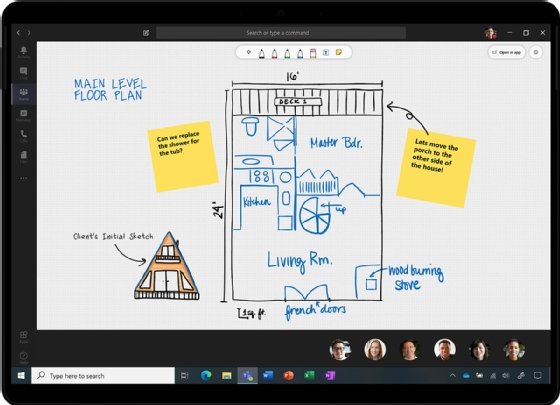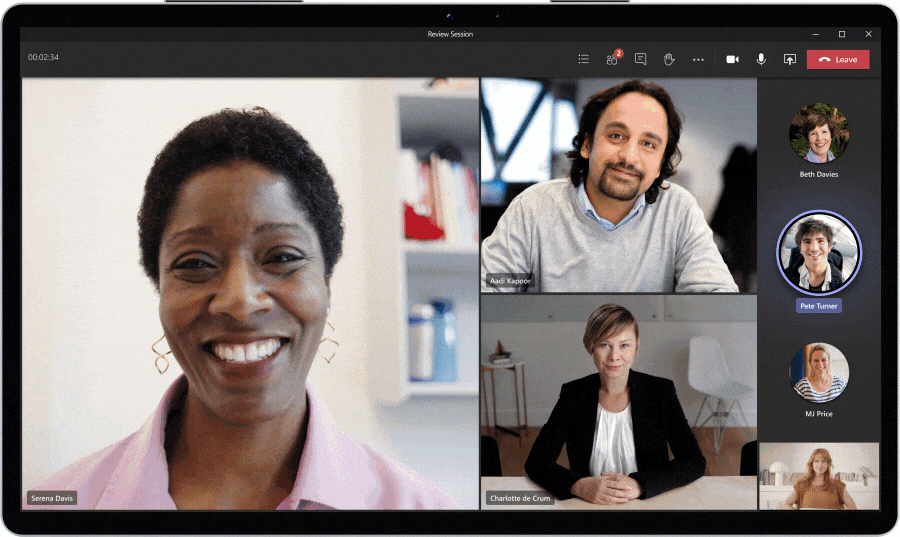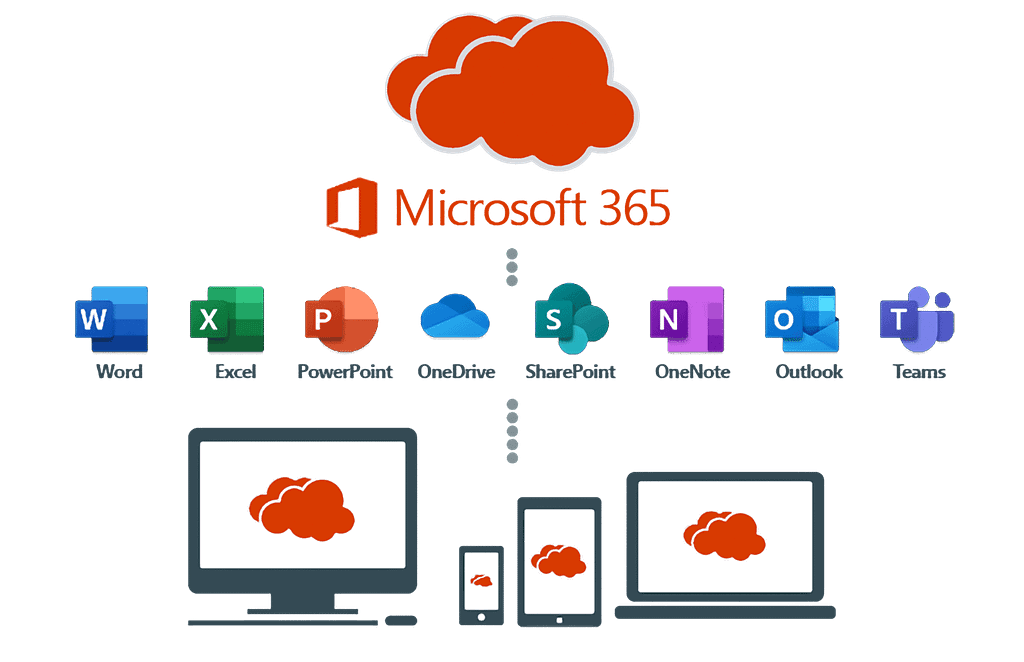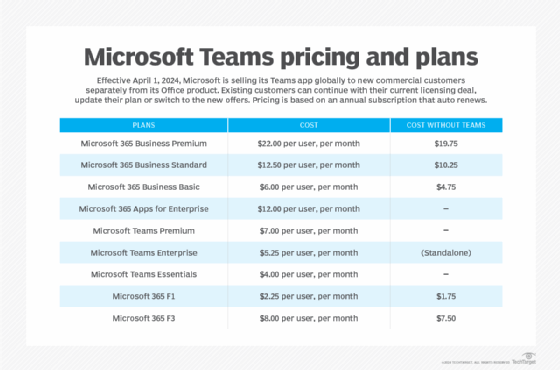Microsoft Teams, a new name for Office 365 Teams
Microsoft Teams is cloud-based team collaboration software that is part of formerly Office 365 now Microsoft 365 suite of applications. The core capabilities in Microsoft 365 Teams include business messaging, calling, video meetings and file sharing. Businesses of all sizes can use Teams.
Teams is Microsoft’s core cloud-based unified communications (UC) offering, and it competes with similar products, such as Slack, Cisco Webex and Google Workspace.
As a business communications app, Teams enables local and remote workers to collaborate on content in real time and near-real time across different devices, including laptops and mobile devices. Microsoft Teams integrates with other Microsoft business applications, including Exchange, PowerPoint and SharePoint.
Microsoft Teams is especially useful for remote collaboration because it keeps dispersed teams of workers connected and communicating. The COVID-19 pandemic compelled organizations worldwide to use Microsoft Teams extensively — as well as other collaboration software — as a communications platform for remote work.
Microsoft Teams is usually deployed across entire organizations and not just within certain company departments. In some cases, Teams could replace email for internal company communication among employees.
Microsoft Teams key features
Microsoft Teams is the hub of team collaboration in Microsoft 365 and Office 365. The platform has several features to help teams of employees communicate and collaborate. Some of the key features are as follows:
- Messaging chat. At its core, Teams is a chat-based collaborative workspace that features group and individual messaging with threaded and persistent conversations. Users can elevate a group or one-on-one chat to a voice or video call. Like other messaging services, Teams messages can incorporate emojis and GIFs (Graphics Interchange Format).
- Calling. Teams provides cloud-based telephony for voice calling. With the Teams app, users can make voice over IP (VoIP) calls between Teams clients. Microsoft Phone System and Calling Plan users can make, receive and transfer calls to and from landlines and mobile phones on the public switched telephone network (PSTN). Microsoft also has Direct Routing, which lets customers connect an existing private branch exchange (PBX) or Session Initiation Protocol (SIP) trunk to Teams. Other Teams calling features include audio conferencing, Enhanced 911 (E911) support, voicemail and several other enterprise-grade calling capabilities.
- Video meetings. In addition to audio-only calls, users can conduct virtual meetings. Amid the COVID-19 pandemic and work-from-home (WFH) directives, video conferencing adoption soared as people collaborated remotely. Teams offers some key video conferencing features, such as customized virtual backgrounds, meeting recording, transcription, whiteboarding and breakout rooms.
 MICROSOFTThe whiteboarding feature in Microsoft Teams can help users collaborate on visual elements.
MICROSOFTThe whiteboarding feature in Microsoft Teams can help users collaborate on visual elements. - Screen sharing. This older but critical capability is a common feature among team collaboration tools. As the name implies, screen sharing enables users to share their desktop screens, including files, in real time during Teams calls or video meetings.
- Calendar. Teams, like Microsoft Outlook email, features extensive calendaring so users can keep track of their workweek, meetings and other daily appointments. The Outlook and Teams calendars are tightly integrated.
- File sharing. In this document management feature, remote teams can store, share and edit files within Teams. Users can collaborate on the same document in real time within Teams.
- Webinars. Microsoft Teams supports interactive meetings and webinars for up to 1,000 attendees. Features include live reactions and host moderation controls to disable attendees’ chat, audio and video. Teams webinars can accommodate 10,000 people in a view-only broadcast. Larger broadcasts of 20,000 people are available through the end of 2021 to accommodate the higher number of remote workers during the pandemic. In 2022, that number will drop to 10,000. Also, attendee reports show who attended the webinar and for how long.
- External collaboration. The guest access feature in Microsoft Teams enables users to invite people outside their organizations to join internal channels for messaging, meetings and file sharing. This capability helps to facilitate business-to-business (B2B) project management. Teams Connect, expected to be generally available in 2021, is another external collaboration feature, enabling different companies to chat, meet and edit documents in a shared workspace in Teams.
Because Teams is cloud-based software, Microsoft can update the platform’s features frequently and quickly. As a result, Microsoft Teams features are constantly evolving.

Basic Microsoft Teams terminology
The Microsoft Teams user interface (UI) is similar to other team collaboration software with a ribbon of workflow icons on the left-hand side of the desktop screen along with a list of teams. Chat collaboration takes place on the center of the desktop screen. Most team collaboration tools use similar terminology to identify certain parts of the UI. For Teams, the terminology includes the following:
- Teams. Teams are groups of people who connect and collaborate on work and other projects.
- Channels. Within each team, users can create channels to organize their communications by topic, like news items, monthly reports or more lighthearted chat. Within channels, users have meetings, conduct conversations and work on files together. Channels can be either public or private. Each channel can include a couple of users or scale to thousands of users.
- Tabs. At the top of each channel are tabs, which link to files, apps and services. Some common tab names include Posts for the messages people have sent and Files for the documents people have shared within the channel.
- Mentions. Users can use mentions to message and alert other users. Mentions use the @ symbol followed by the person’s name. Users can also @mention entire teams and channels.
- Feeds. The activity feed provides a summary of messages, replies, mentions and other activity happening within team channels. The activity feed can be filtered by unread messages, mentions and other categories, as well as the user’s own activity.
- Threads. A series of messages creates a thread. Users replying to a message should select the Reply option instead of creating a new conversation and thread. Threads can become quite long as colleagues chat back and forth. Users can schedule voice and video meetings within threads, which helps to provide contextual communications.
Microsoft Teams integrations

Microsoft Teams integrates with many other applications in the Microsoft 365 and Office 365 suites, including Excel, OneDrive, PowerPoint, SharePoint and Word. For added workplace productivity, Teams also integrates with apps outside the Microsoft domain, such as Box, Cisco Webex Meetings and Zoom. Microsoft Teams App Studio enables developers and businesses to build custom apps that will work with Teams.
In addition to software integrations, Microsoft Teams integrates with hardware components. While Teams video calls are possible through desktops and laptops, Microsoft has partnered with video conferencing hardware vendors, such as Crestron, Logitech and Poly, to integrate Teams with their devices.
Microsoft Teams operates on Android, iOS, macOS and Windows systems and devices. It also works in Chrome, Firefox, Safari and Microsoft Edge web browsers. Firefox and Safari, however, don’t fully support some of the Teams calling and meeting features.
Microsoft Teams pricing plans
Microsoft Teams is available for free, but the free version is not part of Microsoft’s suite of business applications. The paid versions of Teams offer more features and integrations with other Microsoft apps. Several business and enterprise plans are available. Microsoft uses the Microsoft 365 and Office 365 brand names for plans that include Teams.
Microsoft targets several industry verticals with its products. Notably, with Teams, the vendor targets healthcare, frontline workers and education. Government plans — Microsoft 365 Government G3 and G5 — are also available, as are one-month free trials, add-on services and nonprofit pricing.
The chart below details the paid plans that include Microsoft Teams:

Additionally, more expensive plans will have certain calling features included. But those features are only available as add-on services in less expensive plans. Certain security and compliance features, too, will either be included or available as add-on services depending on the payment plan. The more expensive plans will have more advanced security features.
How secure is Microsoft Teams?
Microsoft offers several security features in Teams, including two-factor authentication (2FA), single sign-on (SSO), and encryption of data in transit and at rest. Teams workflows can take advantage of the security features of other integrated Microsoft apps as well, such as SharePoint encryption.
According to Microsoft, the vendor does not have access to customers’ uploaded content. Customer data stays within the customer’s control, and Microsoft does not scan content or teams for purposes unrelated to the service. Microsoft Teams includes the following security features.
- Advanced Threat Protection (ATP), Microsoft’s optional cloud-based service, enables organizations to determine if content in Teams is malicious and block the content from user access.
- Private channels within teams keep conversations private among certain users and isolated from the larger, overall team. Only owners or members of the private channel can access the channel. Private channels are helpful if certain users need an area to discuss sensitive information, such as budgets.
- End-to-end encryption (E2EE) for one-to-one ad hoc VoIP calls is an upcoming security option for organizations conducting sensitive online conversations. Information technology (IT) departments will control who can use E2EE in the organization. This feature will be available to commercial customers in preview in the first half of 2021.
- Safe Links, expected to roll out in March 2021, helps to protect businesses from malicious sites when people click links in Office apps.
- Meeting controls, such as disable video and invite-only options, are upcoming features that should enhance meeting management. Disable video will enable a meeting organizer to disable the video of an individual or all attendees. An invite-only feature will send participants to the meeting lobby if they were not invited directly to the meeting.
Credit: Luke O’Neil, TechTarget


